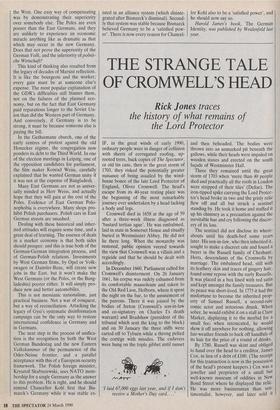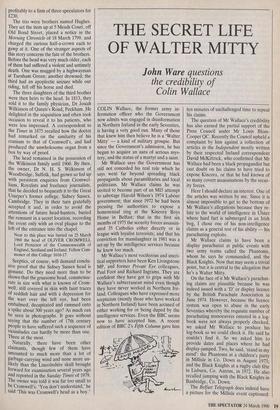THE STRANGE TALE OF CROMWELL'S HEAD
Rick Jones traces
the history of what remains of the Lord Protector
IF, in the great winds of early 1990, ordinary people were in danger of 'collision with sheets of corrugated roofing, up- rooted trees, back copies of The Spectator, or old tin cans, then in the great storm of 1703, they risked the potentially greater nuisance of being assailed by the wind- borne bonce of the late Lord Protector of England, Oliver Cromwell. The head's escape from its 40-year resting place was the beginning of the most remarkable journey ever undertaken by a head lacking a body and legs.
Cromwell died in 1658 at the age of 59 after a three-week illness diagnosed as `bastard tertian ague'. He was embalmed, laid in state in Somerset House and ritually buried in Westminster Abbey. He did not lie there long. When the monarchy was restored, public opinion veered towards the view that Cromwell was a villain and a regicide and that he should be dealt with accordingly.
In December 1660, Parliament called for Cromwell's disinterment. On 26 January 1661, his corpse was rudely exhumed from its comfortable mausoleum and taken to the Old Red Lion, Holborn, where it spent the night on the bar, to the amusement of the patrons. There it was joined by the bodies of Ireton (Cromwell's son-in-law and co-signatory on Charles I's death warrant) and Bradshaw (president of the tribunal which sent the king to the block) and on 30 January the three stiffs were carted off to Tyburn while a throng pelted the cortege with missiles. The cadavers were hung on the triple gibbet until sunset 'I laid 67,000 eggs last year, and if I don't receive a Mother's Day card....' and then beheaded. The bodies were thrown into an unmarked pit beneath the gallows, while their heads were impaled on wooden staves and erected on the south façade of Westminster Hall.
There they remained until the great storm of 1703 when 'more than 40 people died and practically all the roofs in London were stripped of their tiles' (Defoe). The iron-tipped spike carrying the Lord Protec- tor's head broke in two and the grisly relic flew off and all but struck a sentinel standing by. He took it home and stuffed it up his chimney as a precaution against the inevitable hue and cry following the discov- ery of its loss.
The sentinel did not disclose its where- abouts until his death-bed some years later. His son-in-law, who then inherited it, sought to make a discreet sale and found a buyer in the Russell family of Cheshunt, Herts, descendants of the Cromwells by marriage. The embalmed head, still with its leathery skin and traces of gingery hair, found some repose with the early Russells. It was placed in a box lined with red satin and kept amongst the family treasures. But its peace was short-lived. In 1775 it had the misfortune to become the inherited prop- erty of Samuel Russell, a second-rate comic actor and notorious drunk. When sober, he would exhibit it on a stall in Clare Market, displaying it to the morbid for a small fee; when intoxicated, he would show it off anywhere for nothing, allowing fair-weather friends to hack off handfuls of its hair for the price of a round of drinks. By 1780, Russell was skint and obliged to hand over the head to a creditor, James Cox, in lieu of a debt of £100. (The receipt for this transaction is now in the possession of the head's present keepers.) Cox was a jeweller and proprietor of a small but well-known museum of oddities in New Bond Street where he displayed the relic. He was more businessman than sen- timentalist, however, and later sold it profitably to a firm of three speculators for £230.
The trio were brothers named Hughes. They set the item up at 5 Meads Court, off Old Bond Street, placed a notice in the Morning Chronicle of 18 March 1799, and charged the curious half-a-crown each to gawp at it. One of the stranger aspects of this story concerns the fate of the brothers. Before the head was very much older, each of them had suffered a violent and untimely death. One was mugged by a highwayman at Turnham Green; another drowned; the third had an apoplectic seizure while out riding, fell off his horse and died.
The three daughters of the third brother were then heirs to the head. In 1813, they sold it to the family physician, Dr Josiah Wilkinson of Queen's Road, Peckham. He delighted in the acquisition and often took occasion to reveal it to his patients, who were less impressed. A correspondent to the Times in 1875 recalled how the doctor had remarked on the similarity of his cranium to that of Cromwell's, and had produced the unwholesome organ from a box by way of proof.
The head remained in the possession of the Wilkinson family until 1960. By then, the owner, Dr N. H. S. Wilkinson of Woodbridge, Suffolk, had grown so fed up with persistent enquiries from Cromwel- bans, Royalists and freelance journalists, that he decided to bequeath it to the Great Usurper's former college, Sidney Sussex, Cambridge. They in their turn gratefully accepted it and, in order to avoid the attentions of future head-hunters, buried the remnant in a secret location, recording the event only with an oval plaque to the left of the entrance into the chapel:
Near to this place was buried on 25 March 1960 the head of OLIVER CROMWELL Lord Protector of the Commonwealth of England, Scotland and Ireland. Fellow Com- moner of this College 1616-17.
Sceptics, of course, will demand conclu- sive proof that the Sidney Sussex head is genuine. Do they need more than to be shown that the gruesome head, commensu- rate in size with what is known of Crom- well, still covered in skin with faint traces of reddish hair and with a depression for the wart over the left eye, had been embalmed, decapitated and rammed onto a spike about 300 years ago? As much can be seen in photographs. It goes without saying that the number of 17th century People to have suffered such a sequence of vicissitudes can hardly be more than one. Three at the most.
Naturally, there have been other claimants, though few of them have amounted to much more than a lot of garbage-carrying wind and none more un- likely than the Lincolnshire skull brought forward for examination several years ago and reported in the Sunday Times of 1979. The owner was told it was far too small to be Cromwell's. 'You don't understand,' he said 'This was Cromwell's head as a boy.'



















































 Previous page
Previous page